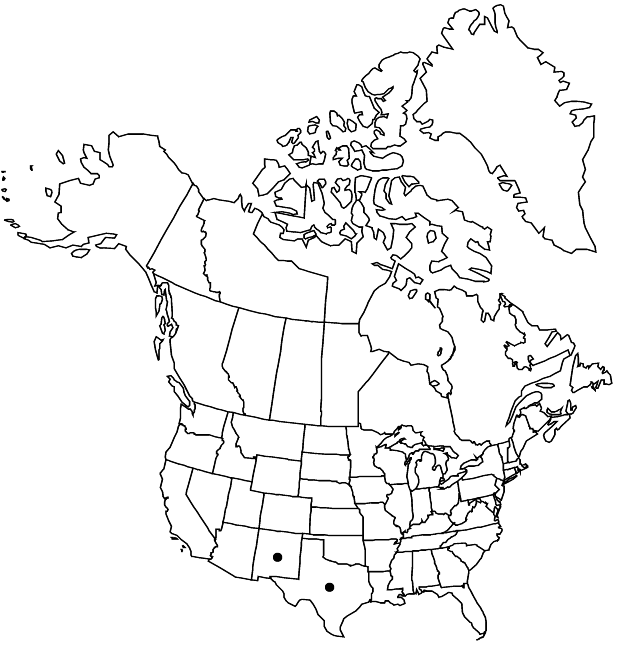Difference between revisions of "Arbutus xalapensis"
in A. von Humboldt et al., Nov. Gen. Sp. 3(fol.): 219.
3(qto.): 279. 1819 ,.
FNA>Volume Importer |
FNA>Volume Importer |
||
| Line 13: | Line 13: | ||
|name=Arbutus texana | |name=Arbutus texana | ||
|authority=Buckley | |authority=Buckley | ||
| − | }}{{Treatment/ID/Synonym | + | }} {{Treatment/ID/Synonym |
|name=Arbutus xalapensis var. texana | |name=Arbutus xalapensis var. texana | ||
|authority=(Buckley) A. Gray | |authority=(Buckley) A. Gray | ||
| Line 31: | Line 31: | ||
|elevation=300-2200 m | |elevation=300-2200 m | ||
|distribution=N.Mex.;Tex.;Mexico;Central America. | |distribution=N.Mex.;Tex.;Mexico;Central America. | ||
| − | |discussion=<p>Arbutus xalapensis is frequent in the Edwards Plateau hill country southwest of Austin, Texas, where it is associated with junipers, oaks, and mesquite at moderate elevations. Westward, in the Chisos, Davis, and Guadalupe mountains, it occurs in the pinyon-juniper zone at higher elevations (to 2200 meters). In the Animas Mountains of Hidalgo County, southwestern New Mexico, A. xalapensis has limited contact with A. arizonica, and some herbarium specimens suggest that hybridization occurs there. Confirmation will require a more detailed analysis of those populations.</p> | + | |discussion=<p><i>Arbutus xalapensis</i> is frequent in the Edwards Plateau hill country southwest of Austin, Texas, where it is associated with junipers, oaks, and mesquite at moderate elevations. Westward, in the Chisos, Davis, and Guadalupe mountains, it occurs in the pinyon-juniper zone at higher elevations (to 2200 meters). In the Animas Mountains of Hidalgo County, southwestern New Mexico, <i>A. xalapensis</i> has limited contact with <i>A. arizonica</i>, and some herbarium specimens suggest that hybridization occurs there. Confirmation will require a more detailed analysis of those populations.</p> |
|tables= | |tables= | ||
|references= | |references= | ||
| Line 55: | Line 55: | ||
|publication year=; | |publication year=; | ||
|special status= | |special status= | ||
| − | |source xml=https://jpend@bitbucket.org/aafc-mbb/fna-data-curation.git/src/ | + | |source xml=https://jpend@bitbucket.org/aafc-mbb/fna-data-curation.git/src/8f726806613d60c220dc4493de13607dd3150896/coarse_grained_fna_xml/V8/V8_754.xml |
|subfamily=Ericaceae subfam. Arbutoideae | |subfamily=Ericaceae subfam. Arbutoideae | ||
|genus=Arbutus | |genus=Arbutus | ||
Revision as of 18:08, 18 September 2019
Shrubs or trees, 2–4(–8) m; bark brick red, peeling in smooth flakes over most larger limbs, retained on base of trunk on older specimens and eventually over most of oldest parts of plant, becoming gray, irregularly roughened (twigs of newly emerging shoots usually densely villous, often with mixture of glandular hairs, fully developed twigs hairy and/or glandular-hairy, or glabrate or glabrous, twig bark soon loosening and exfoliating, older twigs usually smooth, brick red or glaucous-grayish red). Leaves ± equal in size throughout; petiole 1.2–2.5 cm, base slightly decurrent, glabrate; blade green or slightly lighter green abaxially, pale or bright olive-green or glaucous-green, elliptic or slightly ovate-elliptic, (2.5–)4–6(–7.5) × (1.2–)1.8–3(–4) cm, base usually tapered, rarely slightly cordate, (margins smooth or irregularly toothed on sprouts), apex acute or obtuse, surfaces glabrous or ± hairy. Inflorescences (often showy), varying from densely clustered or openly-branched to relatively few-flowered; axes hairy, with both glandular and eglandular hairs intermixed. Pedicels accrescent, obliquely erect to pendulous, 1.6–3.2 mm, hairy, with both glandular and eglandular hairs intermixed; bract (accrescent), clasping base, reddish or tan, scalelike, 1.3–2 mm (to 2.9–3 mm in fruit). Flowers: calyx tan (sometimes with blush of pink), (1.8–3 mm), lobes 1–1.2 mm, apex obtuse or rounded; corolla 5.1–5.4(–6.1) mm (the larger on rapidly developing, more open, and elongated inflorescences); anthers ca. 1.5 mm, spurs 1/2–3/4 times length of thecae; ovary with 2–3(–5) ovules per locule. Berries deep red or blackish red, 5.5–7.5 mm diam. Seeds 2.5–3 mm. 2n = 26.
Phenology: Flowering (Feb-)Mar–Apr(-May); ripe fruit appears after about 6 weeks.
Habitat: Rough, stony hills, mountain slopes, calcareous ledges
Elevation: 300-2200 m
Distribution

N.Mex., Tex., Mexico, Central America.
Discussion
Arbutus xalapensis is frequent in the Edwards Plateau hill country southwest of Austin, Texas, where it is associated with junipers, oaks, and mesquite at moderate elevations. Westward, in the Chisos, Davis, and Guadalupe mountains, it occurs in the pinyon-juniper zone at higher elevations (to 2200 meters). In the Animas Mountains of Hidalgo County, southwestern New Mexico, A. xalapensis has limited contact with A. arizonica, and some herbarium specimens suggest that hybridization occurs there. Confirmation will require a more detailed analysis of those populations.
Selected References
None.